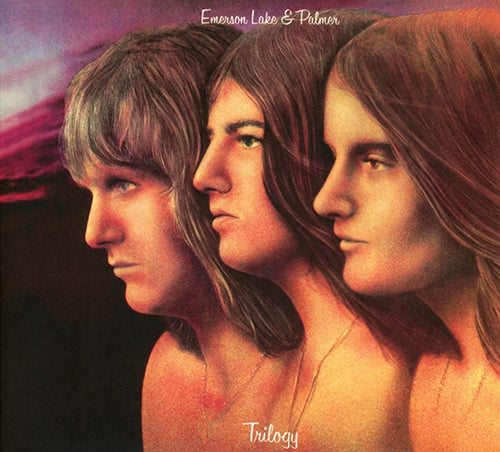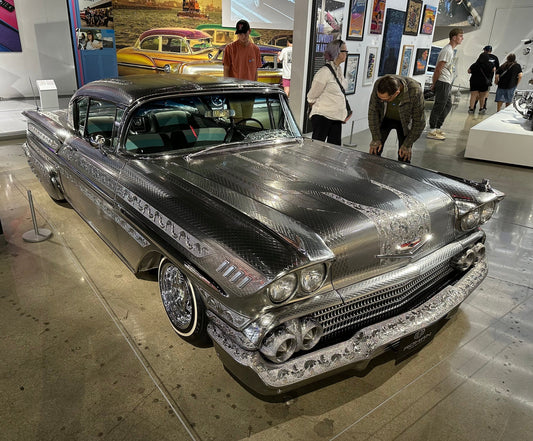It was called progressive rock, but when Emerson, Lake & Palmer played this genre, it looked as much back into music history as it did forward into the newest reaches of sound technology. The group’s inspirations included a wide range of classical music of the 18th through 20th century, not to mention jazz elements. The result was elaborate and mesmerizing, making ELP one of the most influential bands of the early 1970s.
Keith Emerson, the founder of this British trio, played keyboards, especially Hammond organ and Moog synthesizer, but also acoustic classical piano. Greg Lake sang and played bass and guitar as well as being the band’s producer. Just as essential to the band’s character was Carl Palmer’s drumming. In a way, ELP was the forerunner to today’s DIY indie bands, inventing new sound worlds and handling all the details of production on their own.
In the late 1960s, Emerson was the keyboardist for the prog-rock pioneers The Nice, while Lake was King Crimson’s singer and bassist. The two musicians hit it off, and by 1970 they had poached the drummer Palmer from a band called Atomic Rooster. Their first performances as a trio featured arrangements of Mussorgsky’s Pictures at an Exhibition (which ended in live cannon fire!) and Dave Brubeck’s Blue Rondo à la Turk. There were rumors that they planned to play with Jimi Hendrix, which would have been a spectacular match-up, but it was not to be. By autumn, Hendrix had died.
Largely thanks to Emerson’s pre-existing fame, ELP had no trouble finding a record deal. In 1970 they signed with Island Records, plus Atlantic for the American market, and had their eponymous first album out by the end of the year. Their first hit single was “Lucky Man.”
Side One of Emerson, Lake & Palmer is mostly taken up by two classical arrangements. Béla Bartók’s “The Barbarian” was one of the first pieces they had worked on together. There’s also a medley of music by J.S. Bach and Leoš Janáček, with added words by Lake and Richard Fraser, a co-lyricist on a few ELP numbers.
Sandwiched between those classical works is a wholly original song by Lake, called “Take a Pebble.” It’s a perfect exemplar of each ELP member’s contribution to the group: Emerson’s imaginative use of the piano, including strumming the strings like a zither, Lake’s dreamy-eyed singing, and Palmer governing both rhythm and texture at the drums. And halfway through, the track momentarily morphs into a bluegrass romp.
The next album, Tarkus, came out in 1971, a mixture of ideas that together typified a prog rock album: an exploration of a mystical concept on Side One and whatever else they wanted on Side Two. For the concept side, Emerson (with one section by Lake) wrote a 20-minute abstraction that seems to be about an armadillo-like creature called Tarkus who battles an ancient Persian monster called a manticore (human head, lion’s body, spikes like a porcupine). But we get that information more from the album art than from the lyrics.
Side Two is a collection of songs unrelated to the theme. Among these is “The Only Way (Hymn),” one of Lake’s experiments with Bach’s music. In this case, the borrowed material comes from Bach’s Toccata and Fugue in F major, BWV 540 and Prelude and Fugue VI, BWV 851.
The live album Pictures at an Exhibition (1971) captured a performance of one of the band’s early classical arrangements, their version of the beloved Mussorgsky work. The movements of Pictures are musical interpretations of artworks by Russian painter Victor Hartmann. The piece was originally for solo piano but became known mainly through orchestrations by Maurice Ravel and Nikolai Rimsky-Korsakov.
The ELP suite relies on Mussorgsky’s music as a starting point, building new creations around the original ideas. “Blues Variation,” for example, uses the theme from Mussorgsky’s movement called “The Old Castle,” turning it into a manic, punctuated jam for Hammond organ.
The band’s popularity grew quickly in America. The 1972 album Trilogy included their biggest US single, “From the Beginning.” Part of that album’s appeal on this side of the pond might have been the experimental arrangement of “Hoedown” from Aaron Copland’s ballet Rodeo. Since Copland was himself inventing a new take on traditional sounds, the ELP “Hoedown” could be described as Americana twice removed.
Not surprisingly, these pioneers of DIY music wanted complete control of their product. They started Manticore Records in 1973 in time for their next album, Brain Salad Surgery. Much of Side A is filled with individual songs, including Lake’s “Still…You Turn Me On.” Although that unusually melody-driven track has become popular – even emblematic of the band over the subsequent decades – it was not released as a single at the time.
As if to remind the world that their vision was not subject to trends, more than half of that record is taken up by a massive, four-movement prog-rock symphony of sorts called “Karn Evil 9.” Here’s the first part. The interplay between Lake’s voice and the acoustic percussion is particularly interesting.
After only a few years as a band, the three musicians were already getting restless. Instead of putting out regular albums, they began making music in the studio only sporadically. By 1977, they were ready to release the result: a two-volume set of three years’ worth of creativity, called Works. Vol. 1 included their single of Copland’s Fanfare for the Common Man. But that project was not enough to keep them moving forward. Love Beach (1978) was released right before the band split up. They didn’t even tour in support of it.
The long-awaited ELP reunion finally happened in 1992. The trio was determined to do more than just tour their old songs, but also to create new music. They released a record called Black Moon. Critics complained that they were phoning it in when it came to composition and arrangement, but Lake was happy enough with new songs like “Farewell to Arms” and “Paper Blood” to keep playing them after this short-lived reunion.
“Changing States” was an instrumental composed by Emerson, a tour-de-force for synthesizer and organ that also shows off Palmer’s skill and control on high-speed patterns.
The revivified ELP didn’t last long. Their final album is from 1994, In the Hot Seat. Because of nerve damage in his arm, Emerson had lost control of his right-hand fingers. On the last record, he had to overdub the piano parts with two left-hand tracks. The project was both a critical and a popular failure.
But fans did not forget ELP. Their 40th anniversary in 2010 sparked some live performances by ELP (without Palmer) playing old material, plus the release of many remasters and live tracks from the vault.
Emerson continued to make solo albums until 2013, when he was honored with an induction into the Hammond Organ Hall of Fame. Tragically, he died in 2016 of a self-inflicted gunshot wound. Lake died from cancer later that same year. Palmer, now 72, most recently made four albums with a group he called the Carl Palmer Band; he continues to perform. ELP’s days are over, but no amount of time can erase the spot these innovative musicians carved for themselves in the history of rock music.




